Journal #7: Lower Manhattan and The Captivating Chelsea
What another beautiful day! Although
some of our classes have been hot and rainy, today was not one of those days. I
knew that I needed to become mentally prepared today because there were many
stops on our list. As having a very large breakfast and buying a phone cover
for seven bucks, we headed out with the class to start our adventure.
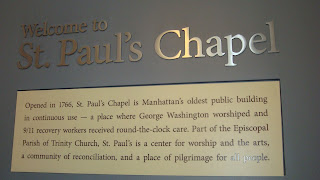
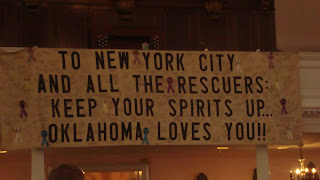
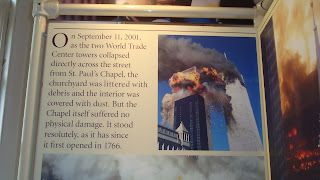
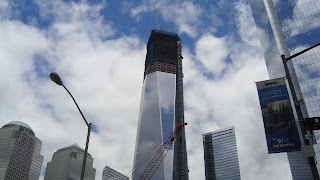
Our first stop was St. Paul’s Chapel
and Churchyard. “It was built for worshippers, who lived too far uptown to make
it down to Wall St (BG, 77).” While other churches became stables, prisons, and
hospitals, during the British occupation, St. Paul’s remained a house of God
and worship for British Officers. Because of the bucket brigade that carried
water from the Hudson, the church survived the fire of 1776, unlike the trinity
church (BG, 77). It was amazing to think that I was standing in the same place
where George Washington went after his inauguration at federal hall (BG, 77).
After 9/11, the World Trade Center Disaster, the church served as a fleeing
ground for firemen, police officers, and medical teams. I remember my dad, a
captain fireman who was involved with 9/11, telling me about the church. It was
one of the few places in the city that “was not covered in sut.” I remember him
saying “that day was one of the hardest days of my life. It helped us to come together
and morn our fallen brothers.” The interior of the building is striking. It is
surrounded with columns and painted with colors of blue, beige and brown (BG,
78). I loved the fact that they had artifacts and writings from
9/11. I feel that it is somewhat of a memorial, other than the waterfalls, that
people can go to and reminisce about their loved ones.

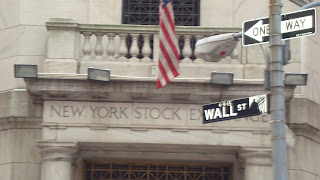
Our next stop was the place where Occupy Wall
Street was held. Occupy Wall Street was
a movement held by people that began on September 17, 2011. It started in
Liberty Square in Manhattan’s Financial District and then spread to places all
over the nation. The goal of Occupy Wall Street was
“fighting back against the corrosive power of major banks and multinational
corporations over the democratic process and the role of Wall Street in
creating an economic collapse that has caused the greatest recession in
generations.” It was crazy to think that I lived through a movement where the
people wanted a voice. People of all ages young and old wanted their voice to
be heard and it was. Occupy Wall Street was on the front page newspaper for
weeks on end. Wall Street is a small street, which runs between Broadway and
the East River. Wall Street gets its name from a wall that ran from river to
river during 1653. During Peter Stuyvesant’s term, the wall served as a barrier
to protect the Dutch from the British Neighbors (BG, 64).
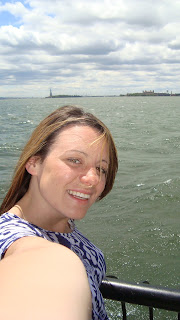
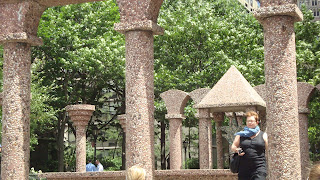

Our next stop was the Trinity Church and Churchyard. This
placed served as the tomb of Alexander Hamilton. After being in the city for a
couple of weeks now, I never knew that so many famous people were buried on the
City’s grounds. The church stands “79 feet wide and 166feet long; its tower
including the sphere stands 281 feet above the ground: for many years it was
the highest point in lower Manhattan (BG, 65).” This class has taught me that
Saint Patrick’s is not the only church in the city. There are many famous
churches and being a practicing catholic, I hope that one day I will be able to
attend a service.
We continued our Journey through the NY Stock Exchange. It
is the world’s largest stock exchange which daily trading values can exceed
over $153 billion dollars DAILY. In recent years, certain stocks have
plummeted, leaving people in distress over their shares. Gradually, the stocks
are coming back up and making a return as NYSE Euronext. This is a fully
electronic stock exchange, which is composed of 4 floors, all dedicated to
trading.
We then went into Federal Hall. George Washington took
his oath in 1789, on the second floor balcony. The hall was renamed Federal
hall in honor of New York’s position as the nation’s capital during that time.
Federal
Hall was essentially the birth place of
American Government. Now it serves as a museum dedicated to our first president
and the start to the United States of American. When we walked in, the walls
were all white and the style was neoclassical. The ceilings were high, with
beautiful chandeliers. It was exciting to think I was standing in a place where
George Washington once stood. A man who basically evolved America, once stood
in this building and took his oath to be the first president of the United
States of America.
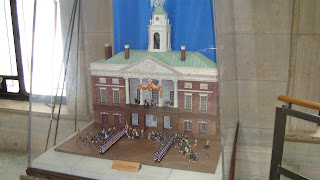
As we ventured on we passed the
customs house, where people had to go through when they came to Ellis Island.
The wind started to pick up as we made our way through Battery
Park. I wish I would have bought a sweater!!! Of course I carry it in my bag
all the other days when I did not need it.
Battery Parkserved as the world’s first
immigrant depot. Before the development of Ellis Island, people from all over
Europe would arrive on the sands of the park. I was stunned to find out that
such a beautiful park was once situated on filled land. It now includes 23
acres of amazing views and a group of monuments which recall the history of New
York’s maritime and history (BG, 46). Although there have been many stories
about the Hudson River, it really was appealing. The sky line of the city and
the view of the boats would make a great day for touring. As we walked down
park there were couples that were reading to each other, music playing, and
people sightseeing. It was the essence of New York.
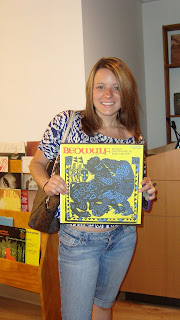

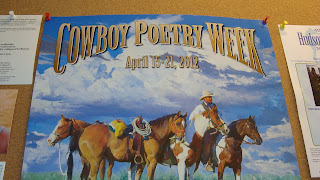
We eventually made our way to the Irish Hunger Memorial.
It was like a piece of Ireland in the middle of the city. It had long grass and
rock that really set the tone for the Irish scene. This memorial is “devoted to
raising public awareness of the events that led to the "Great Irish Famine
and Migration" of 1845-1852. It serves as a reminder to millions of New
Yorkers and Americans who proudly trace their heritage to Ireland, of those who
were forced to emigrate during one of the most heartbreaking tragedies in the
history of the world.” As we learned in high school the Irish were some of the
first immigrants to come to America. Some were treated poorly, so it was
interesting to see a memorial that was dedicated to the heritage. Because I am
a quarter Irish, I think it added to the pleasure of seeing the memorial.
Our next stop was the Poets house. Readings,
workshops, and lectures all take place here. In the words of our tour guide
mike “What don’t’ we do, that doesn’t have to do with poetry.”The house is
funded by the city, state, federal funds, and ‘”rich ladies at the top of the 4
seasons.” The house has just about 3000 members so far. What is do interesting
about this place, is that they will put your work on display. We even got to
see a glimpse of Damien’s work! The house started in 1985 by a woman called
Elizabeth Cray. She came up with the idea for a great poetry library. With the
help of her friend Stanley Coonis, they started the library with 300 books.
Now, about 2000 books are donated yearly from all over the country. Every major
poet has been through this house. I was very fond of Cummings work. He broke
all the rules of literature. He did not like capitalization, he would make a
sentence of two words, and parenthesis would start a line. It was like a poet’s
puzzle that you had to put together. The other work that I was very fond of was
called the between the heart beats, poetry by nurses. These books had hundreds
of poems dedicated to patients and nurses in the field.
Our next Journey was Chelsea! It was
once the home of transvestites, prostitutes, and drugs. Now it is a beautifully
place which is full of modern art and culture. It “owes its name and
approximate boundaries to Captain Thomas Clarke, a retired British soldier who
bought a tract of land in 1750 and named the estate after the royal hospital,
Chelsea, in London, a refuge for old and disables soldiers (BG, 185). We walked
through the Chelsea Market which was composed of Italian, Chinese, and French
foods of all sorts. In 1995, the Nabisco factory reopened as the Chelsea
Market. The ground floor is full of shops where there is gelato, kitchen
supplies, and souvenirs of all kinds (BG, 186). I was upset that we could not
spend more time here, but as I stated before this is just a taste of the city
life.
Now it was time for lunch. I ate at this cute diner down
the block from the market. The price was reasonable for all the food they gave
to you. For $13, I got a cup of soup, chicken wrap, French fries, and a diet
coke. Not too bad for the city prices, right?
After lunch we walked the high
line. The high line was built in the mid-19thcentury. The streets
were crowded and dirty. The high line was created in order to fix these
problems. In the 1990’s, an advocacy group fought to have the 1.6 miles of line
run between west 16th and west 30th street (BG, 188). Now
it is a beautiful way to travel throughout the area. The garden is unique,
there are food vendors, and you can actually look down onto the street while
drinking a cup of coffee. Like the central park, it is a small get away from
city life.

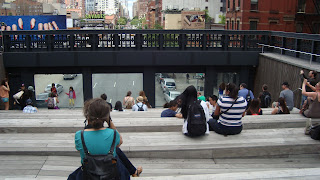
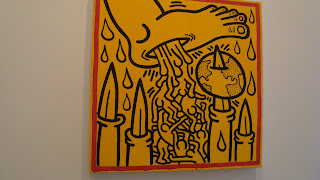
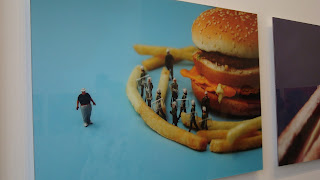
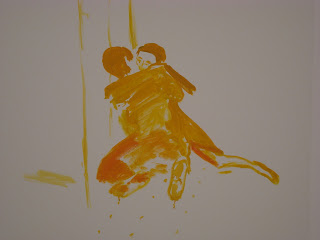
From the high line, we walked down
to the street to go Gallery Hopping. This was an experience in itself. Cups
lying on a box would be considered art. It was funny because people in class
would be sitting on the “art” not knowing it could be a piece worth thousands
of dollars. It was interesting to see all of the artist’s different methods and
ways of creating art. It was a good introduction into the movie that I will be
going to see tonight with some people from class and Mike.
Mike bought us to see a documentary
on Marina Abramovic. Her
way of art is outrageous, fearless, and captivating, all at the same time. Her
method of just looking at one of her fans bought tears to many people’s eyes
and eventually was called a master piece. Some of her pieces were so bazar, but
she made you understand her reasoning for doing so. I never thought in a
thousand years I would enjoy this kind of art, but it actually interests me.
After speaking to my mom about it for over an hour when I got home and her
looking at me like I had two heads, I realized you have to watch the picture in
order to get the true emotion of this wonderful artist.
What another fabulous day in the
city! I’m saddened knowing that it is all going to have to end soon. Between
the museums, history, and art, today could not have been any better. This class
has been exceeding my expectations and I wish there were more opportunities to
learn outside of the classroom.





